In my role as chair of the SLA Information Book Awards I have the immense privilege to see an amazing collection of books every year. However, I am also aware that many people do not have access to many of these books, or even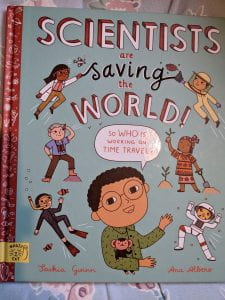 information on how to find them. That is why National Non-fiction November is so valuable and we should all be very grateful to the Federation of Children’s Book Groups, for all of the work they do in promoting this event.
information on how to find them. That is why National Non-fiction November is so valuable and we should all be very grateful to the Federation of Children’s Book Groups, for all of the work they do in promoting this event.
The title I am looking at today is aimed at young children and gives them a fascinating insight into the wide variety of work undertaken by scientists. I suspect that even as adults, we will discover work that is new to us; have you ever heard of an Acoustic Biologist before? The book is laid out in a very clear way, with each profession getting a double page spread. The book is based on the idea of a child asking their parent about scientists and what they do, with the mother then talking through a wide range of subjects that are being studied today. The illustrations are in variably sized boxes ( as with graphic novels and comics), so that it is easy to follow and most children will be familiar with the format. The illustrations are brightly coloured and almost cartoon like in their simplicity, but this makes it easy for the very young reader to understand what is going on. The text is also very simple and whilst many children will read this with an adult, it is also suitable for them to read for themselves, especially with the support of the graphics.
heard of an Acoustic Biologist before? The book is laid out in a very clear way, with each profession getting a double page spread. The book is based on the idea of a child asking their parent about scientists and what they do, with the mother then talking through a wide range of subjects that are being studied today. The illustrations are in variably sized boxes ( as with graphic novels and comics), so that it is easy to follow and most children will be familiar with the format. The illustrations are brightly coloured and almost cartoon like in their simplicity, but this makes it easy for the very young reader to understand what is going on. The text is also very simple and whilst many children will read this with an adult, it is also suitable for them to read for themselves, especially with the support of the graphics.
At the end of the book we have several pages with short notes describing scientists from around the world and who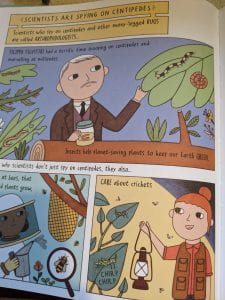 lived at different periods in our history. There are many that I have not heard of before, as well as some that have become more prominent in the last few years; thanks to the growth of biographies in the children’s book world. People like David Attenborough are world famous, but I was happy to see another scientist that I became aware of as a child. At the end of the 1950s, before Jacques Cousteau came on the scene , we were introduced to the wonders of the ocean by the divers, Hans and Lotte Hass, so it is lovely to see a mention of Hans in this book. For the young readers reading and listening to the content of this book, these details can act as a springboard towards discovering more about these, often pioneering, scientists.
lived at different periods in our history. There are many that I have not heard of before, as well as some that have become more prominent in the last few years; thanks to the growth of biographies in the children’s book world. People like David Attenborough are world famous, but I was happy to see another scientist that I became aware of as a child. At the end of the 1950s, before Jacques Cousteau came on the scene , we were introduced to the wonders of the ocean by the divers, Hans and Lotte Hass, so it is lovely to see a mention of Hans in this book. For the young readers reading and listening to the content of this book, these details can act as a springboard towards discovering more about these, often pioneering, scientists.
Because the book is aimed at a young audience, it does not include the usual elements to be found in information books. So, we do not have a contents, index or glossary; however the inclusion of the list of scientists is very helpful. For those in the Foundation stage and KS1, who are introducing children to the world of science, this is a brilliant book to get them excited about the world and what they might choose to do in the future.
Thank you to the Federation of Children’s Book groups for asking me to review the book and also to the publisher ‘Magic Cat‘ for providing a review copy.

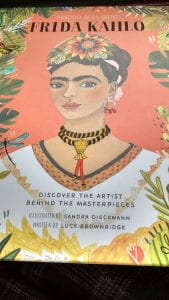 “Frida Kahlo” by Lucy Brownridge and Sandra Dieckmann is a wonderful evocation of the artist’s life and art, aimed at younger children. I have loved her work for a long time, but seeing the exhibition about her life at the V&A in 2018 really brought home how amazing she was. This book mentions her health issues but does not go in to tremendous detail, rather it focuses on her development as an artist and the influence she has had outside Mexico. Sandra Dieckmann has done a tremendous job with the illustrations, bringing her own touches to the work whilst also paying ‘homage’ to Kahlo’s own style. This will make a tremendous addition to any primary school.
“Frida Kahlo” by Lucy Brownridge and Sandra Dieckmann is a wonderful evocation of the artist’s life and art, aimed at younger children. I have loved her work for a long time, but seeing the exhibition about her life at the V&A in 2018 really brought home how amazing she was. This book mentions her health issues but does not go in to tremendous detail, rather it focuses on her development as an artist and the influence she has had outside Mexico. Sandra Dieckmann has done a tremendous job with the illustrations, bringing her own touches to the work whilst also paying ‘homage’ to Kahlo’s own style. This will make a tremendous addition to any primary school. delightful look at coping with a fear of the dark. The young hero finds that he is a ‘bit’ afraid of the dark because of the shadows and various sounds that he cannot identify. So when his father takes him on an overnight camping trip he is really worried by the idea of the dark. However he has a revelation when it is truly dark; for it is then that he can really see all the stars in the night sky. This is a story of finding the beautiful and positive in something that we are not sure about and it is great for young readers. There are lovely illustrations and a really imaginative use of cutouts in many of the pages, which brings everything to life.
delightful look at coping with a fear of the dark. The young hero finds that he is a ‘bit’ afraid of the dark because of the shadows and various sounds that he cannot identify. So when his father takes him on an overnight camping trip he is really worried by the idea of the dark. However he has a revelation when it is truly dark; for it is then that he can really see all the stars in the night sky. This is a story of finding the beautiful and positive in something that we are not sure about and it is great for young readers. There are lovely illustrations and a really imaginative use of cutouts in many of the pages, which brings everything to life.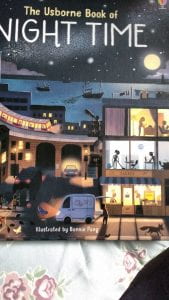 “The Usborne book of Night time” by Usborne and Bonnie Pang is aimed at younger children, perhaps up to lower KS2. It takes the concept of night and then gives us a double page spread to look at the various elements that make up the night. There are factories and cities, the sea and the sky, nocturnal animals, northern lights and different parts of the world; all of these are working while we are sleeping. This is a great introduction to understanding our world and can lead on to some really fascinating discoveries for the young readers.
“The Usborne book of Night time” by Usborne and Bonnie Pang is aimed at younger children, perhaps up to lower KS2. It takes the concept of night and then gives us a double page spread to look at the various elements that make up the night. There are factories and cities, the sea and the sky, nocturnal animals, northern lights and different parts of the world; all of these are working while we are sleeping. This is a great introduction to understanding our world and can lead on to some really fascinating discoveries for the young readers.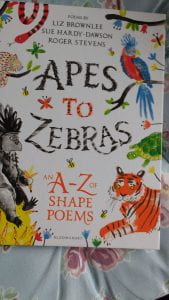 collection of poetry, but importantly it is an A-Z of shape poetry. I think most of us find writing poetry quite challenging, so to find that these poets have created stunning work and all in the shape of various animals is quite amazing. The layout of the book and the simple use of colour really helps the words and shapes stand out but it is the imagination of the writers that really makes this book so stunning.
collection of poetry, but importantly it is an A-Z of shape poetry. I think most of us find writing poetry quite challenging, so to find that these poets have created stunning work and all in the shape of various animals is quite amazing. The layout of the book and the simple use of colour really helps the words and shapes stand out but it is the imagination of the writers that really makes this book so stunning.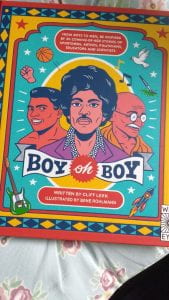 “Boy oh Boy” by Cliff Leek and Bene Rohlmann is a look at 30 men, both living and dead, who have had an impact on the way that we look at men and our expectations of them. Many of these people are household names, but others have not made headlines outside their immediate areas, yet they have had an effect on the way that people think and behave and they have even changed the laws of the land. These people are from around the world and from a wide range of ethnic backgrounds, which shows that everyone has the potential to be great. The illustrations are very bright and strong and are somewhat 1950s in style, making the work stand out from others. After so many books about strong females recently it is good to see a book that looks at broadening the range of biographies.
“Boy oh Boy” by Cliff Leek and Bene Rohlmann is a look at 30 men, both living and dead, who have had an impact on the way that we look at men and our expectations of them. Many of these people are household names, but others have not made headlines outside their immediate areas, yet they have had an effect on the way that people think and behave and they have even changed the laws of the land. These people are from around the world and from a wide range of ethnic backgrounds, which shows that everyone has the potential to be great. The illustrations are very bright and strong and are somewhat 1950s in style, making the work stand out from others. After so many books about strong females recently it is good to see a book that looks at broadening the range of biographies.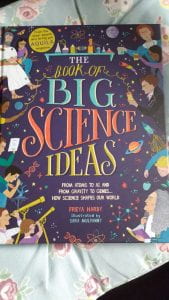 and gives us a double page spread of ‘big thinkers’ in that area and then it looks at the development of our knowledge. Subjects covered vary from the periodic table, animal classification, and astronomy to computers, big data, and renewable energy. Whilst this does not have an index it does have a good glossary which will help the readers understand the new terms thy come across.
and gives us a double page spread of ‘big thinkers’ in that area and then it looks at the development of our knowledge. Subjects covered vary from the periodic table, animal classification, and astronomy to computers, big data, and renewable energy. Whilst this does not have an index it does have a good glossary which will help the readers understand the new terms thy come across.